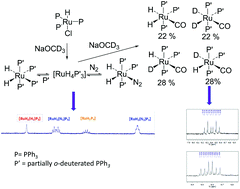当前位置:
X-MOL 学术
›
Dalton Trans.
›
论文详情
Our official English website, www.x-mol.net, welcomes your
feedback! (Note: you will need to create a separate account there.)
Insight into the mechanism of decarbonylation of methanol by ruthenium complexes; a deuterium labelling study†‡
Dalton Transactions ( IF 3.5 ) Pub Date : 2018-06-15 00:00:00 , DOI: 10.1039/c8dt01733f Patrizia Lorusso 1, 2, 3, 4 , Graham R. Eastham 4, 5, 6, 7 , David J. Cole-Hamilton 1, 2, 3, 4
Dalton Transactions ( IF 3.5 ) Pub Date : 2018-06-15 00:00:00 , DOI: 10.1039/c8dt01733f Patrizia Lorusso 1, 2, 3, 4 , Graham R. Eastham 4, 5, 6, 7 , David J. Cole-Hamilton 1, 2, 3, 4
Affiliation

|
In the reaction of [RuHClP3] (P = PPh3) with NaOMe in methanol, the product is [RuH2(CO)P3]. Short reaction times show that the final product is formed through [RuH4P3] as the major intermediate. Using NaOCD3 in CD3OD, the first formed product is [RuH4P′3] (P′ is PPh3 partially deuterated in the ortho positions of the aromatic rings). Further reaction leads to a mixture of [RuHnD2−n(CO)P3] (n = 0, 22%; n = 1, 2 isomers each 28%; n = 2, 22%). Mechanistic aspects of both steps of the reaction are explored and, together with previously published calculations, they provide definitive mechanisms for both dehydrogenation and decarbonylation in these interesting systems.
中文翻译:

深入了解钌络合物对甲醇脱羰的机理;氘标记研究† ‡
在甲醇中[RuHClP 3 ](P = PPh 3)与NaOMe的反应中,产物为[RuH 2(CO)P 3 ]。短的反应时间表明,最终产物是通过[RuH 4 P 3 ]作为主要中间体而形成的。使用NaOCD 3在CD 3 OD中,第一形成产物是[期RuH 4 P' 3 ](P'是PPH 3在部分氘化邻芳族环的位置)。进一步反应导致[期RuH的混合物Ñ d 2- Ñ(CO)p 3 ](Ñ = 0,22%;n = 1,2个异构体,每个28%;n = 2,22%)。探索了反应的两个步骤的机理,并与先前发表的计算一起,为这些有趣的系统中的脱氢和脱羰提供了确定的机制。
更新日期:2018-06-15
中文翻译:

深入了解钌络合物对甲醇脱羰的机理;氘标记研究† ‡
在甲醇中[RuHClP 3 ](P = PPh 3)与NaOMe的反应中,产物为[RuH 2(CO)P 3 ]。短的反应时间表明,最终产物是通过[RuH 4 P 3 ]作为主要中间体而形成的。使用NaOCD 3在CD 3 OD中,第一形成产物是[期RuH 4 P' 3 ](P'是PPH 3在部分氘化邻芳族环的位置)。进一步反应导致[期RuH的混合物Ñ d 2- Ñ(CO)p 3 ](Ñ = 0,22%;n = 1,2个异构体,每个28%;n = 2,22%)。探索了反应的两个步骤的机理,并与先前发表的计算一起,为这些有趣的系统中的脱氢和脱羰提供了确定的机制。











































 京公网安备 11010802027423号
京公网安备 11010802027423号